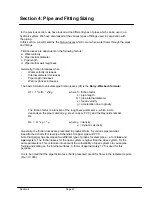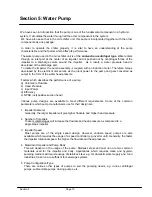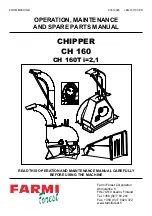
Equivalent Pipe Length
The concept of equivalent pipe length is very useful in calculating friction losses along the
hydronic
pipe
system.
Defination:
The equivalent pipe length of a component in the pipe system is the length of a
straight pipe which will give the same friction losses as the component itself.
For example, we have a 1" elbow which gives a pressure drop of
∆
P when a
flowrate of Q passes through it. If a straight 1" pipe of length
y
feet gives the same
pressure drop when a flowrate of Q flows through it, then, the equivalent pipe length
of that elbow is
y
feet.
It is just like thinking that the elbow has been "replaced" with the length of straight
pipe.
Naturally, a straight pipe in the hydronic system do not require such usage of equivalent length.
Therefore, the total equivalent pipe length of a hydronic system
= straight pipe equivalent pipe length of all fittings and valves along the
pipe
Generally, equivalent pipe lengths of common valves and fittings are available. See attached
tables
(Appendix
7).
An alternative method was published in the "
ASHRAE Handbook: Fundamentals
" for calculating
the equivalent pipe length of tee joints. A graph is used to determine the number of equivalent
elbows for the various flow conditions through the tee. This is then multiplied with the equivalent
pipe length/pressure loss for the same size elbow. See Appendix 7.
It must be noted that the equivalent lengths given in the attached tables for the fittings are
only estimates.
The values are more meaningful when used for steel pipes.
Friction losses of copper and PVC fittings (e.g. elbows, tees, reducers) are quite similar to the
equivalent steel type. Therefore, for estimation purposes, it is sufficient that the same equivalent
lengths to be used for both copper and PVC pipes.
Nevertheless, friction loss values for different pipe material will be used in the computation of the
total friction in the piping system.
If specific friction losses for any fitting is available from the manufacturer, it is advisable to use
these values instead of the estimates given in the tables. This is especially applicable to valves
(specific C
v
) and strainers (different mesh sizes).
Section 4
Page 70
Содержание AC 40A
Страница 1: ...AM MAC ...
Страница 153: ...Appendix 1 ...
Страница 154: ...Appendix 2 Appendix 2 ...
Страница 157: ...GRAPH OF PRESSURE DROP VS FLOW FOR VARIOUS C V RATINGS Appendix 5 1 ...
Страница 158: ......
Страница 159: ...Water Capacity Graph Appendix 5 2 ...
Страница 160: ...CHART 3 FRICTION LOSS FOR CLOSED PIPING SYSTEMS Appendix 6 1 ...
Страница 161: ...CHART 4 FRICTION LOSS FOR OPEN PIPING SYSTEMS Appendix 6 2 ...
Страница 162: ...CHART 5 FRICTION LOSS FOR CLOSED AND OPEN PIPING SYSTEMS Appendix 6 3 ...
Страница 168: ...Appendix 8 Appendix 8 ...
Страница 169: ...Appendix 8 1 ...
Страница 170: ...Appendix 8 2 ...
Страница 171: ...Appendix 8 3 ...
Страница 172: ...Appendix 8 4 ...
Страница 173: ...Appendix 8 5 Appendix 8 5 ...
Страница 174: ...Appendix 8 6 Appendix 8 6 ...
Страница 175: ...Appendix 8 7 Appendix 8 7 ...
Страница 176: ...Appendix 9 ...
Страница 178: ...Appendix 11 1 Appendix 11 1 ...
Страница 179: ...Appendix 11 2 Appendix 11 2 ...
Страница 180: ...Appendix 13 ...
Страница 181: ...Appendix 13 1 ...
Страница 182: ...Appendix 14 Appendix 14 ...
Страница 183: ...Appendix 15 1 Appendix 15 1 ...
Страница 186: ...Appendix 17 Appendix 17 ...
Страница 187: ...Appendix 18 ...
Страница 188: ...CE20DW CE25DW Note PRESSURE DROP CORRECTION FACTOR 1 2947 0 0021 EWTºF Appendix 19 ...
Страница 189: ... 2003 McQuay International 603 55194922 www mcquayup com ISO 9002 REGISTERED ...
















































